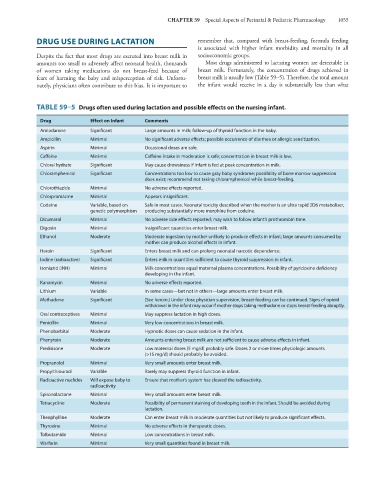Page 1069 - Basic _ Clinical Pharmacology ( PDFDrive )
P. 1069
CHAPTER 59 Special Aspects of Perinatal & Pediatric Pharmacology 1055
DRUG USE DURING LACTATION remember that, compared with breast-feeding, formula feeding
is associated with higher infant morbidity and mortality in all
Despite the fact that most drugs are excreted into breast milk in socioeconomic groups.
amounts too small to adversely affect neonatal health, thousands Most drugs administered to lactating women are detectable in
of women taking medications do not breast-feed because of breast milk. Fortunately, the concentration of drugs achieved in
fears of harming the baby and misperception of risk. Unfortu- breast milk is usually low (Table 59–5). Therefore, the total amount
nately, physicians often contribute to this bias. It is important to the infant would receive in a day is substantially less than what
TABLE 59–5 Drugs often used during lactation and possible effects on the nursing infant.
Drug Effect on Infant Comments
Amiodarone Significant Large amounts in milk; follow-up of thyroid function in the baby.
Ampicillin Minimal No significant adverse effects; possible occurrence of diarrhea or allergic sensitization.
Aspirin Minimal Occasional doses are safe.
Caffeine Minimal Caffeine intake in moderation is safe; concentration in breast milk is low.
Chloral hydrate Significant May cause drowsiness if infant is fed at peak concentration in milk.
Chloramphenicol Significant Concentrations too low to cause gray baby syndrome; possibility of bone marrow suppression
does exist; recommend not taking chloramphenicol while breast-feeding.
Chlorothiazide Minimal No adverse effects reported.
Chlorpromazine Minimal Appears insignificant.
Codeine Variable, based on Safe in most cases. Neonatal toxicity described when the mother is an ultra rapid 2D6 metabolizer,
genetic polymorphism producing substantially more morphine from codeine.
Dicumarol Minimal No adverse side effects reported; may wish to follow infant’s prothrombin time.
Digoxin Minimal Insignificant quantities enter breast milk.
Ethanol Moderate Moderate ingestion by mother unlikely to produce effects in infant; large amounts consumed by
mother can produce alcohol effects in infant.
Heroin Significant Enters breast milk and can prolong neonatal narcotic dependence.
Iodine (radioactive) Significant Enters milk in quantities sufficient to cause thyroid suppression in infant.
Isoniazid (INH) Minimal Milk concentrations equal maternal plasma concentrations. Possibility of pyridoxine deficiency
developing in the infant.
Kanamycin Minimal No adverse effects reported.
Lithium Variable In some cases—but not in others—large amounts enter breast milk.
Methadone Significant (See heroin.) Under close physician supervision, breast-feeding can be continued. Signs of opioid
withdrawal in the infant may occur if mother stops taking methadone or stops breast-feeding abruptly.
Oral contraceptives Minimal May suppress lactation in high doses.
Penicillin Minimal Very low concentrations in breast milk.
Phenobarbital Moderate Hypnotic doses can cause sedation in the infant.
Phenytoin Moderate Amounts entering breast milk are not sufficient to cause adverse effects in infant.
Prednisone Moderate Low maternal doses (5 mg/d) probably safe. Doses 2 or more times physiologic amounts
(>15 mg/d) should probably be avoided.
Propranolol Minimal Very small amounts enter breast milk.
Propylthiouracil Variable Rarely may suppress thyroid function in infant.
Radioactive nuclides Will expose baby to Ensure that mother’s system has cleared the radioactivity.
radioactivity
Spironolactone Minimal Very small amounts enter breast milk.
Tetracycline Moderate Possibility of permanent staining of developing teeth in the infant. Should be avoided during
lactation.
Theophylline Moderate Can enter breast milk in moderate quantities but not likely to produce significant effects.
Thyroxine Minimal No adverse effects in therapeutic doses.
Tolbutamide Minimal Low concentrations in breast milk.
Warfarin Minimal Very small quantities found in breast milk.

